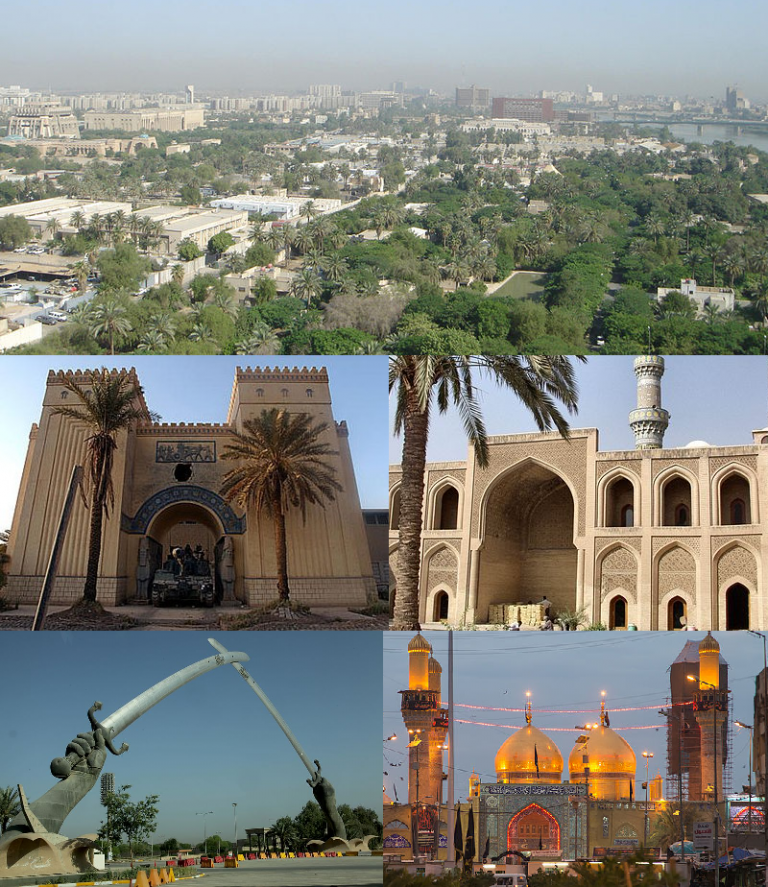Baghdad
is the capital of
Iraq.
Located along the
Tigris River
, the city was founded in the 8th century and became the capital of
the
Abbasid Caliphate. Within a short time of its inception, Baghdad evolved into a
significant cultural, commercial, and intellectual center for the
Islamic world. This, in addition to housing several key academic institutions
(e.g.,
House of Wisdom), as well as hosting multiethnic and multireligious environment,
garnered the city a worldwide reputation as the “Centre of Learning”.
Baghdad was the largest city of the
Middle Ages
for much of the Abbasid era, peaking at a population of more than a
million. The city was largely
destroyed
at the hands of the
Mongol Empire
in 1258, resulting in a decline that would linger through many
centuries due to frequent plagues and multiple successive empires.
With the recognition of Iraq as an independent state (formerly the
British Mandate of Mesopotamia) in 1938, Baghdad gradually regained some of its former prominence
as a significant center of
Arab culture. With a population variously estimated at over 6 or over 7 million
Baghdad is the largest city in Iraq.
In contemporary times, the city has often faced severe infrastructural
damage, most recently due to the
2003 invasion of Iraq, and the subsequent
Iraq War
that lasted until December 2011. In recent years, the city has been
frequently subjected to
insurgency
attacks. The war had resulted in a
substantial loss of cultural heritage and historical artifacts
as well. As of 2018, Baghdad was listed as one of the least hospitable
places in the world to live, ranked by
Mercer
as the worst of 231 major cities as measured by quality-of-life.
Al-Shaheed, (Martyr’s Monument), Zawra Park, Baghdad.
Administratively, Baghdad Governorate is divided into
districts
which are further divided into
sub-districts. Municipally, the governorate is divided into 9 municipalities,
which have responsibility for local issues. Regional services,
however, are coordinated and carried out by a mayor who oversees the
municipalities. There is no single
city council
that singularly governs Baghdad at a municipal level. The governorate
council is responsible for the governorate-wide policy.
The CPA convened a series of meetings in each neighbourhood to explain
local government, to describe the caucus election process and to
encourage participants to spread the word and bring friends, relatives
and neighbours to subsequent meetings. Each neighbourhood process
ultimately ended with a final meeting where candidates for the new
neighbourhood councils identified themselves and asked their
neighbours to vote for them.
Once all 88 (later increased to 89) neighbourhood councils were in
place, each neighbourhood council elected representatives from among
their members to serve on one of the city’s nine district councils.
The number of neighbourhood representatives on a district council is
based upon the neighbourhood’s population. The next step was to have
each of the nine district councils elect representatives from their
membership to serve on the 37 member Baghdad City Council. This three
tier system of local government connected the people of Baghdad to the
central government through their representatives from the
neighbourhood, through the district, and up to the city council.
The same process was used to provide representative councils for the
other communities in Baghdad Province outside of the city itself.
There, local councils were elected from 20 neighbourhoods (Nahia) and
these councils elected representatives from their members to serve on
six district councils (Qada). As within the city, the district
councils then elected representatives from among their members to
serve on the 35 member Baghdad Regional Council.
The first step in the establishment of the system of local government
for Baghdad Province was the election of the Baghdad Provincial
Council. As before, the representatives to the Provincial Council were
elected by their peers from the lower councils in numbers proportional
to the population of the districts they represent. The 41 member
Provincial Council took office in February 2004 and served until
national elections held in January 2005, when a new Provincial Council
was elected.
This system of 127 separate councils may seem overly cumbersome;
however, Baghdad Province is home to approximately seven million
people. At the lowest level, the neighbourhood councils, each council
represents an average of 75,000 people.
The nine District Advisory Councils (DAC) are as follows:
The city is located on a vast plain bisected by the
Tigris
river. The Tigris splits Baghdad in half, with the eastern half being
called “
Risafa” and the Western half known as “
Karkh“. The land on which the city is built is almost entirely flat and
low-lying, being of
alluvial
origin due to the periodic large floods which have occurred on the
river.

Panoramic view of the Tigris as it flows through Baghdad
Baghdad has a
hot desert climate, featuring extremely hot, dry summers and mild winters.
In the summer, from June through August, the average maximum
temperature is as high as 44 °C (111 °F), accompanied by blazing
sunshine. Rainfall has, in fact, been recorded on fewer than half a
dozen occasions at this time of year and has never exceeded 1
millimetre (0.04 in). Even at night temperatures in summer are seldom
below 24 °C (75 °F). Baghdad’s record highest temperature of 51
degrees Celsius (124 degrees Fahrenheit) was reached in July 2015. The
humidity
is typically under 50% in summer due to Baghdad’s distance from the
marshy southern Iraq and the coasts of
Persian Gulf, and
dust storms
from the deserts to the west are a normal occurrence during the
summer.
Winters boast temperatures typical of
subtropical climates. From December through February, Baghdad has maximum temperatures
averaging 15.5 to 18.5 °C (59.9 to 65.3 °F), though highs above 21 °C
(70 °F) are not unheard of. Lows below freezing occur a couple of
times per year on average.
Annual rainfall, almost entirely confined to the period from November
through March, averages approximately 150 mm (5.91 in), but has been
as high as 338 mm (13.31 in) and as low as 37 mm (1.46 in). On 11
January 2008, light snow fell across Baghdad for the first time in 100
years.






